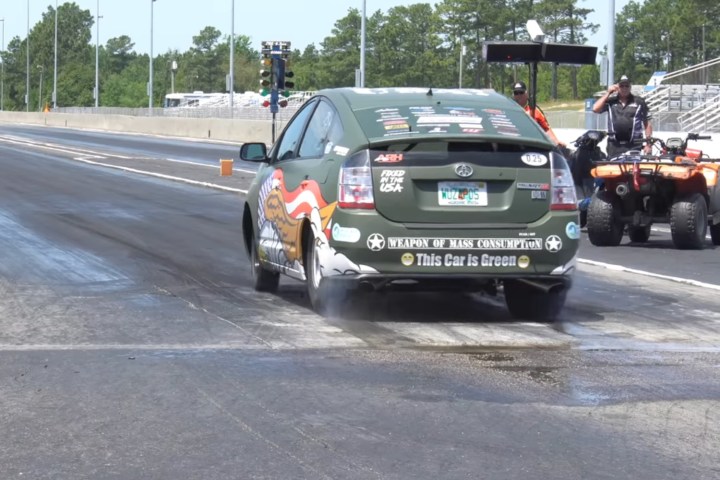
For enthusiasts, the Toyota Prius is the anti-car. It’s looked upon with the same contempt that a committed foodie has for frozen TV dinners. New York-based American Racing Headers, however, believes it has finally found a way to inject driving pleasure and performance into the original hybrid, and the recipe calls for a large serving of Hellcat.
Stuffing a supercharged, 6.2-liter Hellcat V8 engine under the Prius’ hood sounds impossible, but it’s not if you’re handy with an angle grinder and a welder. American Racing Headers cut out most of the sheet metal beyond the windshield, and dropped the Prius’ bare body on a tubular frame made from scratch. The mounts that hold the engine in place are attached directly to the frame, as is all of the running gear. In other words, this build — which is cleverly named PriuSRT8 — is essentially a Toyota hybrid body dropped on a hot rod platform.
The eight-cylinder makes 1,000 horsepower — about 300 more than stock — thanks to a bigger supercharger. Power is sent to the rear wheels through a six-speed manual transmission; this might be the world’s first rear-wheel drive Prius with a stick shift. The entire suspension system has been redesigned from the ground up to handle the extra power, and bigger brakes supplied by Wilwood help rein in the Hellcat’s cavalry when it’s time to bring the action to a stop. Finally, gasoline is stored in a fuel cell that takes up most of the cargo compartment, and then some. Underneath the body, there aren’t many components left that are stamped with a Toyota parts number.
“This is arguably the most politically incorrect car I’ve ever built,” quips the company, referring to the Prius’ original mission of providing humble, low-emissions transportation to the masses.
American Racing Headers recently took the PriuSRT8 to a drag strip, where it blasted through the quarter mile in 9.38 seconds at 147 mph. To add context, it’s a few tenths of a second faster than the Challenger Demon, Dodge’s purpose-designed drag racer, and more than a second faster than a bone-stock Challenger Hellcat. That’s just the beginning; company founder Nick Filippides promises to shave about a second from the PriuSRT8’s quarter-mile time.
Update: Added up-to-date information about the project.



